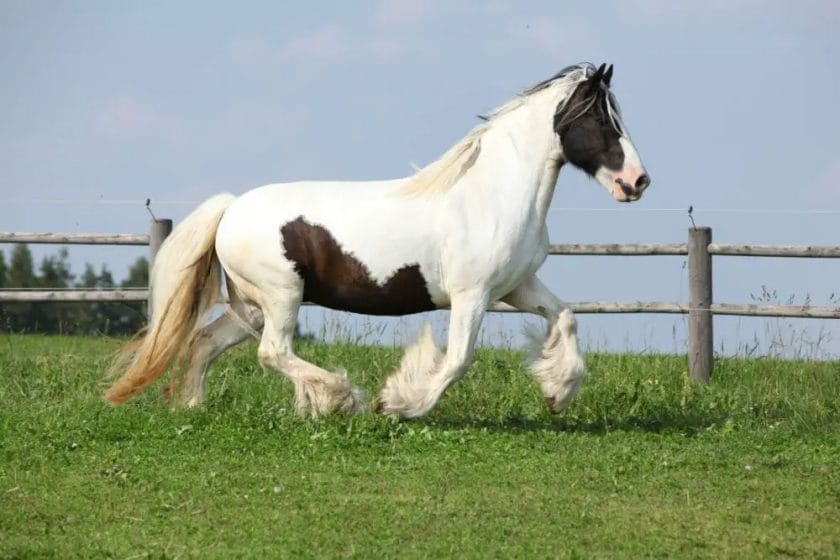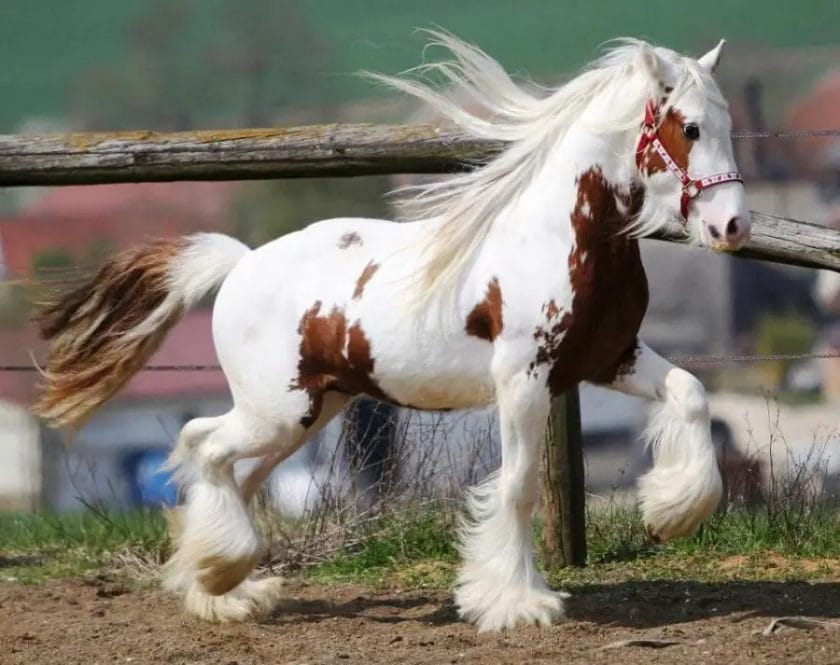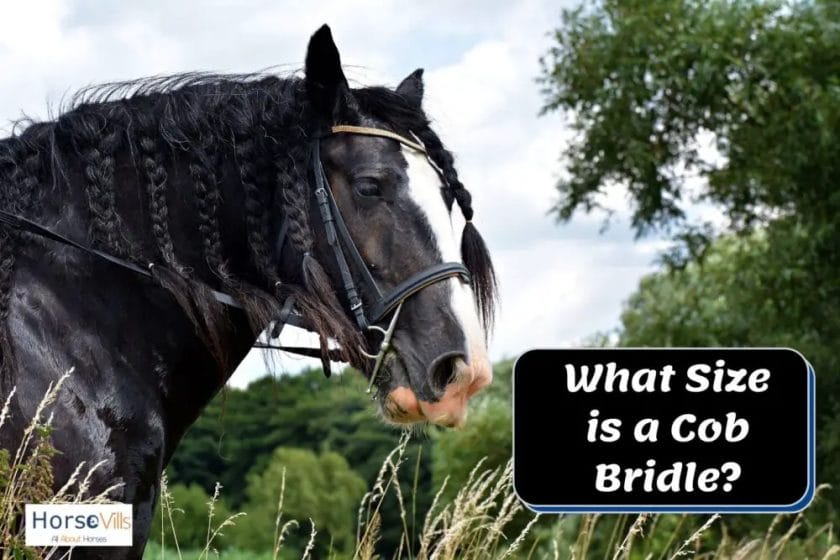A Cob horse is a medium-sized breed that is known for its strength, versatility, and sweet temperament.
These horses typically stand between 14 and 15.2 hands high, making them a perfect size for riders of all ages and levels of experience.
Their stocky build and muscular physique enable them to excel in a variety of disciplines, including driving, riding, and even jumping.
With their compact size and gentle nature, Cob horses are often a popular choice for riding schools, leisure riders, and those who enjoy participating in various equestrian activities.
Whether you’re looking for a reliable mount for pleasure riding or a versatile partner for competitions, a Cob horse is sure to be a great choice.

Cob Horse Size Categories and Classifications
Cob horses are known for their sturdy build, versatility, and friendly temperament. They have been used for various purposes, including riding, driving, and even agricultural work. Cob horses come in different sizes, and their categorization is based on their height and build. In this section, we will explore the different size categories and classifications of cob horses.
Pony Cob
The smallest category of cob horses is the pony cob. Pony cobs typically measure less than 14 hands (56 inches) at the withers. Despite their smaller size, they possess all the characteristics that make cobs desirable. Pony cobs are often used by children or small adults for riding or driving.
Cob
The next size category is simply referred to as “cob.” Cob horses are typically between 14 and 15 hands (56-60 inches) in height. They are known for their strong build, muscular bodies, and thickset necks. Cobs are versatile horses that excel in various disciplines, including showing, dressage, and pleasure riding.
Maxi Cob
The largest size category of cob horses is the maxi cob. Maxi cobs are taller than 15 hands (60 inches) at the withers. They have a more substantial build compared to standard cobs, with robust bone structure and well-developed muscles. Maxi cobs are often used for heavier riders or for carrying more significant loads, such as in driving competitions or farm work.
Cob Types
In addition to size categories, cob horses can also be classified based on their build and purpose. Here are some common cob types:
- Show Cob: Show cobs have a more refined appearance and are bred for their elegance and presence in the show ring. They often have a higher head carriage and longer, more arched necks.
- Working Cob: Working cobs are bred for their strength and endurance. They are often used in agricultural work or as carriage horses due to their ability to pull heavy loads.
- Riding Cob: Riding cobs are versatile horses that can excel in various equestrian disciplines, including dressage, jumping, and hacking. They have a balanced build and are suitable for riders of different skill levels.
In summary, cob horses are categorized based on their size, with pony cobs being the smallest, followed by standard cobs, and maxi cobs being the largest. Additionally, cobs can also be classified based on their build and purpose, including show cobs, working cobs, and riding cobs. Whether you are looking for a reliable riding companion or a capable driving horse, there is a cob horse size and type to suit your needs.

Factors Influencing the Size of Cob Horses
Cob horses are known for their sturdy build, strong physique, and versatility. They are a popular choice among horse enthusiasts for various activities such as riding, driving, and even jumping. The size of a cob horse can vary significantly, and several factors can influence their overall size and build. In this section, we will explore the key factors that play a role in determining the size of cob horses.
1. Breed
The breed of a cob horse can have a significant impact on their size. There are different breeds of cob horses, such as Welsh Cobs, Irish Cobs, and Gypsy Cobs. Each breed has its own standard size range, which influences how tall and robust the horse will be. For example, Welsh Cobs tend to be smaller in size, typically ranging from 13 to 15 hands high, while Gypsy Cobs are known for their larger build and can reach heights of 14.2 to 15.2 hands.
2. Genetics
Genetics also plays a crucial role in determining the size of cob horses. The genes inherited from their parents can influence their height, bone structure, and overall body composition. If both parents are on the smaller side, it is likely that the offspring will also be smaller. On the other hand, if the parents are larger, the foal is more likely to grow into a bigger cob horse.
3. Nutrition
The nutrition provided to cob horses during their development stages can significantly impact their size and growth. A well-balanced diet that provides the necessary nutrients, including protein, vitamins, and minerals, is essential for their overall health and development. Proper nutrition ensures that the horse reaches their full potential in terms of size and muscle development.
4. Exercise and Activity
The level of exercise and activity that cob horses engage in can also affect their size. Regular exercise and physical activity help in building strong muscles and bone density, contributing to a more robust and well-developed physique. Horses that are consistently active and receive proper exercise from a young age are more likely to reach their maximum potential size.
5. Environmental Factors
Environmental factors, such as climate and living conditions, can have an impact on the size of cob horses. Horses living in colder climates tend to be smaller in size as their bodies adapt to the harsh conditions. Additionally, the availability of pasture and the quality of forage can also influence the growth and development of cob horses.
6. Age
The age at which the size of cob horses is measured also plays a role. Younger horses may not have reached their full height and body proportions, while mature horses have already reached their maximum potential size. It is important to consider the age of the horse when assessing their size.
In summary, the size of cob horses is influenced by several factors, including breed, genetics, nutrition, exercise, environmental conditions, and age. Understanding these factors can help horse owners and enthusiasts better manage the growth and development of cob horses, ensuring they reach their full potential in terms of size and physical abilities.

Popular Uses and Disciplines for Cob Horses
Cob horses are a versatile breed that is known for their strength, intelligence, and gentle temperament. They have been bred for centuries and are widely used for various purposes. In this section, we will explore some of the popular uses and disciplines for cob horses.
1. Riding
Cob horses are often used for riding due to their sturdy build and comfortable gaits. They are known for their smooth ride and are suitable for riders of all levels, from beginners to experienced riders. Their calm and steady nature makes them ideal for pleasure riding, trail riding, and even long-distance riding.
2. Driving
Cob horses excel in carriage driving and are commonly seen pulling elegant carriages in parades and competitions. Their strength and power make them well-suited for this discipline. They are often used in both single and multiple horse hitches and can pull heavy loads with ease.
3. Show Ring
Many cob horses have a striking appearance and are well-suited for the show ring. They often participate in various equestrian events such as showing, dressage, and jumping competitions. Their athleticism and gracefulness make them stand out in the ring and they are often successful in these disciplines.
4. Therapy and Assistance
Cob horses have a calm and patient temperament, which makes them ideal candidates for therapy and assistance work. They are often used in equine-assisted therapy programs to help individuals with physical, cognitive, or emotional challenges. Additionally, they can be trained as guide horses to assist individuals with visual impairments.
5. Farm Work
Cob horses have a long history of being used in agricultural work. They are strong, agile, and well-suited for farm tasks such as plowing fields, pulling carts, and hauling heavy loads. Their versatility and hardworking nature make them valuable assets on farms.
6. Pony Club Activities
Cob horses are popular choices for young riders and pony club activities. They are reliable and patient, making them excellent mounts for children learning to ride and participate in various equestrian activities. Cob horses are often used in pony club events such as gymkhana, show jumping, and cross-country.
7. Leisure Driving
Many cob horse owners enjoy leisure driving with their horses. It is a recreational activity that allows them to explore the countryside at a leisurely pace. Whether it’s a scenic drive through the countryside or a relaxed outing in a park, cob horses provide a pleasurable driving experience.
In summary, cob horses have a wide range of uses and disciplines. From riding and driving to therapy work and farm tasks, they prove to be versatile and reliable partners. Their strength, intelligence, and gentle nature make them popular choices for various equestrian activities. Whether you are a leisure rider, a competitive show participant, or someone in need of equine-assisted therapy, cob horses offer something for everyone.
Importance of Proper Size Considerations for Cob Horse Ownership
Owning a cob horse can be a fulfilling and rewarding experience. These sturdy and versatile horses are known for their gentle temperament and suitability for various equestrian activities. However, one critical aspect that potential owners must consider before bringing a cob horse into their lives is size. Proper size considerations are essential to ensure the well-being and safety of both the horse and its rider.
When it comes to cob horses, size matters. These horses typically fall into the medium to large size range, with a height range of 14 to 15.2 hands. Their strong build and stocky physique make them ideal for carrying heavier riders or participating in activities that require strength, such as pulling carriages or working on farms. However, it is crucial to match the size and weight of the rider to the horse appropriately.
Choosing the Right Cob Horse Size
Selecting a cob horse that is the right size for its rider is essential to maintain balance, stability, and overall safety. If a rider is too heavy or too tall for a horse, it can put excessive strain on the horse’s joints and back, leading to discomfort, lameness, or even long-term health issues. Conversely, a rider who is too light or too small for the horse may have difficulty controlling the animal, resulting in potential accidents or loss of control.
To determine the appropriate size of a cob horse for a specific rider, several factors need to be taken into account. These factors include the rider’s height, weight, level of experience, and intended use of the horse. It is advisable to seek professional guidance from trainers or equine experts who can assess the rider’s needs and suggest suitable horse size options.
Considerations for Rider Weight
Rider weight is a significant factor when it comes to proper size considerations for cob horse ownership. Horses have weight-carrying limits, and exceeding these limits can result in discomfort and potential health issues for the horse. The recommended guideline is for a rider to weigh no more than 20% of the horse’s body weight. For example, if a cob horse weighs 1000 pounds (454 kg), the rider should not weigh more than 200 pounds (90 kg).
It is important to note that weight distribution also plays a crucial role. A rider with good balance and core strength can effectively distribute their weight, making it easier for the horse to carry them. Regular exercise and maintaining a healthy weight are beneficial not only for the rider’s well-being but also for the horse’s comfort and overall performance.
Safety and Performance Considerations
Ensuring the right size horse for a rider is not only crucial for their safety but also impacts the performance and well-being of the horse. If a horse is consistently carrying a rider who is too heavy or too small, it can cause imbalance and affect the horse’s movement and performance. This imbalance can lead to physical discomfort or behavioral issues for the horse, adversely affecting its overall training and development.
Additionally, an ill-fitting saddle or equipment can also impact a horse’s comfort and performance. It is vital to invest in proper fitting saddles and tack that suit both the horse’s size and the rider’s needs. Regular saddle fittings by a professional saddle fitter can help ensure that the horse’s back is not subjected to unnecessary pressure or discomfort.
Conclusion
Proper size considerations are of utmost importance when it comes to cob horse ownership. Matching the size and weight of the rider to the horse appropriately ensures the well-being, safety, and performance of both the horse and its rider. Seeking professional guidance and considering factors such as rider weight, height, experience, and intended use can help in selecting the right-sized cob horse. By prioritizing size considerations, horse owners can create a harmonious partnership with their cob horses, allowing for enjoyable and fulfilling equestrian experiences.
FAQs
1. What is the average size of a cob horse?
The average size of a cob horse can vary, but they generally range from 14 to 15.2 hands (56 to 61 inches) in height. However, it’s important to note that cob horses can come in different shapes and sizes, so individual measurements may vary.
2. Can cob horses be suitable for riding?
Yes, cob horses are often suitable for riding. They have a strong build and are known for their versatility. Cobs are commonly used for pleasure riding, hacking, and even some competitive disciplines such as dressage and show jumping.
3. What are some common characteristics of cob horses?
Cob horses typically have a compact and muscular build, with a broad chest, short back, and strong legs. They often have a calm and gentle temperament, making them well-suited for various equestrian activities. Cobs are also known for their thick manes, tails, and feathering on their lower legs.
Conclusion
In conclusion, the size of a cob horse can vary depending on the breed and individual. While there is no specific measurement for a cob horse, they are generally considered to be medium-sized horses with strong build and sturdy conformation.
These versatile horses are valued for their calm temperament, intelligence, and ability to excel in various disciplines. Whether they are used for riding, driving, or as a family companion, cobs are known for their versatility and steady nature.
With their compact size and muscular build, cob horses are often sought after by equestrians of all levels, making them a popular choice in the horse world.
